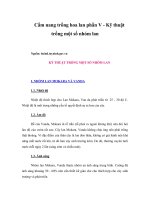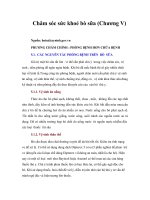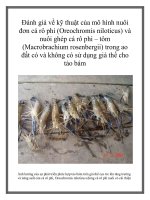Skinless v notched fillet yields oftilapia (oreochromis)
Bạn đang xem bản rút gọn của tài liệu. Xem và tải ngay bản đầy đủ của tài liệu tại đây (830.79 KB, 9 trang )
Skinless V-Notched Fillet Yields ofTilapia (Oreochromis)
S.P. Kirkup1, L.S. Marsh 2*, C.W. Coale, Jr. 3
1774 Old Brook Rd.
Charlottesville, VA 22901 USA
1
2
Department of Biological Systems Engineering (0303)
Virginia Polytechnic Institute and State University
Blacksburg, VA 24061 USA
Department of Agricultural and Applied Economics
(0401)
Virginia Polytechnic Institute and State University
Blacksburg, VA 24061 USA
3
* Corresponding author's e-mail:
Keywords: tilapia, Oreochromis, fish, fillet, yield
International Journal of Recirculating Aquaculture 5 (2004) 19-27. All Rights Reserved
© Copyright 2004 by Virginia Tech and Virginia Sea Grant, Blacksburg, VA USA
International Journal of Recirculating Aquaculture, Volume 5, June 2004
19
Fillet Yields of1ilapia (Oreochromis)
ABSTRACT
White hybrid tilapia (Oreochromis) produced in an experiment that
determined the effects of various management practices on growth rate
and feed conversion ratios were weighed, measured, and filleted at the
conclusion of the growth trials. Regression analyses produced two models
to predict fillet yields-one model that used the fish weight and length
and a reduced model that used only fish weight. While the full model
produced a somewhat smaller error, it was found to be impractical to
use fish length to estimate fillet yield due to the difficulty in obtaining
a length measurement. The full model also produced unreasonable
estimates when extended beyond the limits of the data set. Using a paired
t-test, fillet yields of males and females of equal weights were tested and
were not found to be significantly different. This model provides a means
of converting market price of tilapia fillets to a price for live fish, once
processing costs are considered.
INTRODUCTION
Marketed food commodities, including fish, undergo changes in product
form before reaching the consumer. The objective of changing the
product form of a commodity is to add value to the product. In the case of
filleted fish products, changing a whole fish to a filleted product enhances
the value of the product, but also significantly reduces its weight. The
producer is paid not for the live weight of the fish, but for the final weight
in commodity form. Producers raising fish for the fillet market need a
simple means of estimating fillet yield in order to make management
decisions regarding what size of live fish to harvest.
Market demand for various forms of tilapia has been created in large
metropolitan areas of the United States and Canada by ethnic groups from
regions including South and Central America, Southeast Asia, Africa,
China, and the Philippines. Although most of the tilapia consumed in the
United States is imported as fresh or frozen fillets or frozen whole fish
(Harvey 2000), certain ethnic groups prefer live fish, for which they are
willing to pay a significant premium. High transportation and handling
costs make importation of live tilapia into the United States prohibitively
expensive, and thus a domestic live tilapia industry has developed within
the United States, primarily using intensive recirculating aquaculture
systems. While the amount of tilapia produced domestically is rather
small compared to that of catfish and trout, according to the USDA
20
International Journal of Recirculating Aquaculture, Volume 5, June 2004
Fillet Yields ofTilapia (Oreochromis)
(Harvey 2000), tilapia represents the second largest import of finfish into
the United States on a live weight and value basis, trailing only Atlantic
salmon. Hence, there is ample evidence of a market for tilapia.
Tilapia cannot survive in low ambient temperatures (Phipippart and
Ruwet 1982) and therefore, except for the southernmost regions, they
cannot be produced year-round in ponds in North America. Production
costs of tilapia raised in ponds have been estimated to range between
$0.88 and $1.32/kg (Fitzsimmons and Posadas 1997), compared to an
estimated production cost of $2.79/kg for recirculating aquaculture
systems (Losordo and Westerman 1994). Because of the significantly
higher cost of indoor, temperature-controlled production, domestic
producers generally cannot compete economically with foreign, pondraised, processed tilapia products, which are relatively inexpensive to
ship. However, they can compete for the live tilapia market due to the
challenges and costs associated with transporting live fish.
Many wholesalers require a minimum size for live tilapia; producers
report both 340 and 450 g (three-quarters and one pound) as minimum
desired weights. Producers are tempted to retain, and grow out further
fish that are too small to be marketed as live fish. However, research
conducted at Virginia Tech indicates that as tilapia mature, both the
growth rate and feed-conversion efficiency decrease dramatically (Kirkup
et al. 2000), and that these decreases are primarily dependent on age
rather than either size or culture conditions. Therefore it might be more
economical to fillet substandard fish rather than allowing these poor
performers to grow to live-market size.
Tilapia fillet yields are of interest to domestic producers for several reasons.
First, fillet yield can be used to establish the value of live tilapia, once
the market price and processing, handling, and carcass disposal costs are
known. Secondly, fillet yield and variation are of interest to food processors
and restaurateurs who are interested in a specific size fillet or portion.
In the spring and early summer of 1999 an experiment was conducted to
investigate the effects of different temperature and feeding rates upon the
growth and feed conversion efficiency of "Rocky Mountain" white tilapia.
As a result of the experiment, there was large variation in size, length,
and weight among the fish in the various treatments. At the conclusion of
the experiment, the fish were weighed, measured, sexed, filleted, and the
fillets were weighed.
International Journal of Recirculating Aquaculture, Volume 5, June 2004
21
Fillet Yields of Tilapia (Oreochromis)
MATERIALS AND METHODS
The fish used for the experiment are commonly called "Rocky Mountain
White Tilapia", although a best guess is that they are a white inter-specific
species of the genus Oreochromis, primarily 0. niloticus, 0. aureus, and
0. mossambicus. This hybrid has been selectively bred at Blue Ridge
Aquaculture Inc., (Martinsville, VA, USA) for its color and growth rate.
The white hybrids are desirable in the live fish market because of their
generally attractive external appearance. This hybrid grows rapidly and
has other physiological attributes that make it well suited to culture in
high-density aquaculture systems. Although predominantly white, the
fish ranged in color from a bright white to a bluish and golden white
to a few that were colored a reddish brown. As fry, the fish were given
methyltestosterone mixed with their feed to chemically sex reverse the
females. Prior to delivery to Virginia Tech, the fish were graded twice
at Blue Ridge Aquaculture, Inc. to obtain a relatively uniform size by
removing the runts.
The fish were raised in 660.7 L (150 gallon) agricultural watering
troughs (Rubbermaid, Winchester, VA, USA). The experiment was a
three (temperatures) by four (feeding levels) factorial design having two
replicates. The nominal culture temperatures were 26, 29, and 32°C and
the feeding levels for each temperature, conducted four times a day, were
saturation feeding, 87, 73, and 60% of the daily saturation feed rate. The
average fish weight at the beginning of the experiment was approximately
53g, and the growth experiment lasted 20 weeks. At the conclusion of the
experiment, the fish were taken off feed for three days prior to harvesting.
The tanks were completely drained and the live fish from each tank were
placed in an ice-filled chest. The fish were kept on ice for several hours
prior to being filleted to anesthetize them and increase rigor, making
them easier to fillet and reducing the amount of blood in the fillet. Prior
to processing, the fish were weighed to the nearest gram using a digital
scale, and measured to the nearest millimeter using a measuring board.
Fish weighing 300g or more were then filleted; smaller fish were dissected
to determine sex but were not filleted. A total of 407 fish were filleted. As
noted, the fish used in this experiment were chemically sex reversed, i.e.,
from female to male, and thus, during the filleting process, only 10% were
identified as females. Of that 10%, a disproportionate number of females
did not reach the 300g minimum cut-off weight for filleting; thus only 24
fish identified as females were filleted.
22
International Journal of Recirculating Aquaculture, Volume 5, June 2004
Fillet Yields ofTilapia (Oreochromis)
The filleting was conducted by two competent fish cutters with extensive
experience in filleting tilapia for a small Midwestern tilapia producer.
The v-notched skinless filleting was primarily accomplished with electric
carving knives. One individual cut across the torso just behind the gill,
and then cut horizontally, down along the backbone through the ribcage
to the tail. While still attached to the tail, the side of the fish was then
flipped over and another horizontal cut was made along the skin to
separate the meat from the skin and scales. The sex of the fish was then
determined based upon the internal sex organs. The procedure was
repeated on the other side of the fish. The other individual cut the ribcage
out of the fillet with an electric knife and removed the pectoral fin with
a v-shaped cut. The combined weights of the fillets for each fish were
determined to the nearest gram on a digital scale.
RESULTS
Fillet Weight Model
A mathematical model of the fillet weight (Wf) in grams was fitted using
the linear regression procedure (SAS, Cary, NC, USA). Considered
in the model were polynomials of weight and length, condition factor,
temperature and feeding rate, sex, and interaction terms of the primary
factors. Only fish weight (W) in grams and length (L) in millimeters
were found to be significant at the 95% confidence level, and the
resulting model was Wr = 65.0 - 0.403L + 0.401 W, with a coefficient of
determination (r2) of 0.913. The reduced model, Wr =-16.7 + 0.336W,
produced an r2 of 0.906. The fillet weight versus fish weight data and
the regression line are shown in Figure 1. It appears that weight is a
--·
Figure I. Relationship between fish weight and total fillet weight.
International Journal of Recirculating Aquaculture, Volume 5, June 2004
23
Fillet Yields o/1ilapia (Oreochromis)
very good predictor of fillet yield, and that for a given weight, shorter,
fatter fish produce a slightly higher yield. Although losing some
predictive power, the reduced model is more appropriate for several
reasons. Fish length and weight are highly correlated, and therefore
most of the predictive capability of length can be accounted for in the
weight measurement. The large positive intercept and the large negative
coefficient for length in the full model are intuitively illogical. Beyond the
limits of the data set, the full model produces unreasonable predictions.
For example, predicted fillet weight of fingerlings would exceed the entire
weight of the fish. On the other hand, the coefficients of the reduced
model are intuitively logical, and produce reasonable estimates of the
fillet weights even beyond the limits of the data collected. For the reduced
model, the 95% confidence interval for they-intercept is -21.5 to -11.9,
and the 95% confidence interval for the weight coefficient is 0.326 to
0.347. Considering the variation in yield introduced by the filleting
process, the linear correlation between fillet yield and weight is good.
Effect of Sex on Fillet Yields
As noted previously, fillet yield is a function of size and on average, the
females were only 66.6% as heavy as their male counterparts for a given
treatment. The question to be answered is whether the fillet yields of
males and females of similar weights are different. Once this is known, it
can be determined whether unisex production should be priced differently
than mixed-sex production. As noted above, gender was not a significant
factor in the construction of the fillet model, but a paired t-test is a
stronger statistical test. For each of the 24 filleted females, a male was
selected at random that had the same or nearly the same body weight.
A paired t-test was used to compare the fillet weights and fish lengths
of equal-sized males and females. At the p = 0.05 level, the differences
in fillet yields were not significant, but the males were found to be
significantly longer. F tests were used to compare the variance of the fillet
weights and the lengths. At the p 0.05 level, no statistical difference
could be detected in the variance of the fillet weights or lengths.
=
24
International Journal of Recirculating Aquaculture, Volume 5, June 2004
Fillet Yields ofTilapia (Oreochromis)
Table 1. Comparison of length, weight, fillet weight, and yield of males and
females of comparable weight.
Length
(mm)
Weight (g)
Fillet
Weight (g)
Yleld (%)
Average
267.0
14.7
375.8
64.7
108.7
24.4
0.29
0.024
Females Average
261.8
15.3
376.0
64.7
110.3
21.9
0.29
0.02
Males
(SD)
(SD)
DISCUSSION
Weight is a good predictor of fillet yield. The full model regression
formula that included both fish weight and fish length produced a model
with slightly greater predictive power than the reduced model that
used only fish weight, and could thus be of interest from an academic
perspective. Its predictive power is only slightly better than that of the
reduced model. From a practical perspective, weight is relatively easy to
measure, whereas length is not, and thus for commercial applications, the
reduced model is a more valuable tool than the full model.
The wholesale price per kilogram for tilapia is generally based upon fish
weight-fish heavier than 600g bring a premium price, those between
approximately 350 and 600g an intermediate price, and those less than
350g a lesser price (Fitzsimmons and Posadas 1997). The reduced model
predicts yields of 28.8% and 30.8% for 350g and 600g fish respectively,
which would justify a price premium of approximately 7% based strictly
upon the increase in yield, but which does not include any reduction in
processing costs. The yields obtained from this experiment are lower than
both the 33% yield figure cited as a rule of thumb by Fitzsimmons and
Posadas (1997) and the average fillet yield of 33.5% from 0. niloticus
averaging 207.4g, cited by Obanu and lkeme (1988). In contrast, Clement
and Lovell (1994) obtained only a 25.4% fillet yield from 0. niloticus
that weighed an average of 585g. Several factors could account for the
discrepancies, including tilapia species and the skill of the fish cutter.
However, the largest source of variation is likely to be the methods
and procedures used in filleting, which unfortunately are generally not
reported in the literature. Variability introduced by fillet technique and
skill of the cutter is not included in this model, because only one set of
cutters was used.
International Journal of Recirculating Aquaculture, Volume 5, June 2004
25
Fillet Yields of Tilapia (Oreochromis)
Fillet yield is important information for making management decisions
in pricing fish products, selecting species, specifying feed rations, and
controlling production costs. Muscle yield of fish species has a big impact
on the profitability of the aquaculture firm and on the survival of a
specific marketing channel. The fish producer is the last claimant to the
consumer's market price for fish and fish products. The more handlers
there are operating in a marketing channel, the smaller the margins
for each handler. Gross retail margins for fresh fish usually command
between 30 and 50% of the total profit, depending on the marketing
season and the fish species. Producers are accustomed to marketing whole
fish, while customers are used to purchasing fish fillets. When the useable
flesh is separated from the whole fish, the result is the fillet and a byproduct. Typically, these by-products of the fish filleting process do not
have significant value and their production cost has already been factored
into the fish value. The higher the yield ratio of muscle to by-product
and the higher the market price the greater the chance a producer has
of receiving a higher return on the aquaculture product. Documentation
of fillet yields, coupled with market price, indicate the value of the fish
products in a marketing channel. The better the yield, the better the
survival of a species in the marketplace.
ACKNOWLDEGEMENT
This material is based upon work supported by the Cooperative State
Research Education and Extension Service, U.S. Department of
Agriculture, under Project No. VA135559.
REFERENCES
Clement, S., Lovell, R.T. Comparison of Processing Yield and Nutrient
Composition of Cultured Nile Tilapia (Oreochromis niloticus) and
Channel Catfish (Ictalurus punctatus). Aquaculture 1994. 119, 299310.
Fitzsimmons, K., Posadas, B.C. Consumer Demand for Tilapia Products
in the U.S. and the Effects on Local Markets in Exporting Countries.
In Proceedings of the Fourth International Symposium on Tilapia
in Aquaculture (Orlando, FL, USA). Fitsimmons, K. (Ed.) 1997.
NRAES-106, Natural Resource, Agriculture, and Engineering
Service (NRAES), Ithaca, NY, USA.
26
International Journal of Recirculating Aquaculture, Volume 5, June 2004
Fillet Yields o/Tilapia (Oreochromis)
Harvey, D. 2000. Aquaculture Outlook. Economic Research Service, U.S.
Department of Agriculture (Pub. LDP-AQS-12). Washington, D.C.,
USA.
Kirkup, S.P., Marsh, L.S., Libey, G.S., Heath, A.G., Coale, C.W., Haugh,
C.G. Effects of Temperature and Feeding Rates upon Growth and
Feed Conversion Ratios in Tilapia. In Proceedings of the Third
International Conference on Recirculating Aquaculture (Roanoke,
VA, USA). Flick, G. J. and Rakestraw, T. (Eds.) 2000. Virginia Tech,
Blacksburg, VA, USA.
Losordo, T.M., Westerman, P.W. An Analysis of Biological, Economic
and Engineering Factors Affecting the Cost of Fish Production
in Recirculating Aquaculture Systems. Journal of the World
Aquaculture Society 1994. 25,193-203.
Obanu, Z.A., lkeme, A.I. Processing Characteristics and Yield of Some
Fishes of the River Niger in Nigeria. In Proceedings of the FAQ
Expert Consultation on Fish Technology in Africa (Abidjan, Cote
D'Ivoire). FAQ Fish Report 1988. Supplement No. 400, pages 218220.
Phipippart, J-Cl., Ruwet, J-Cl. Ecology and Distribution of Tilapias. In:_
ICLARM Conference Proceedings 7 (Bellagio, Italy, 1980). Pullin,
R.S.V. and Lowe-McConnell, R.H. (Eds.) 1982. International Center
for Living Aquatic Resources Management (ICLARM, Manila,
Philippines.









